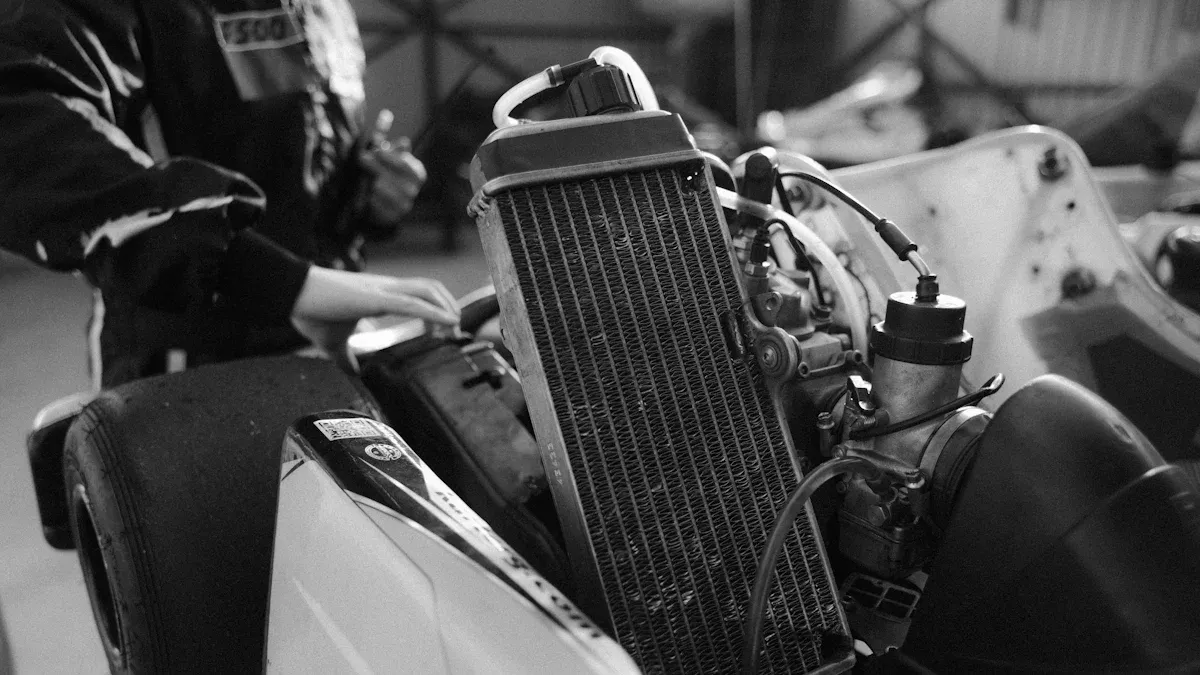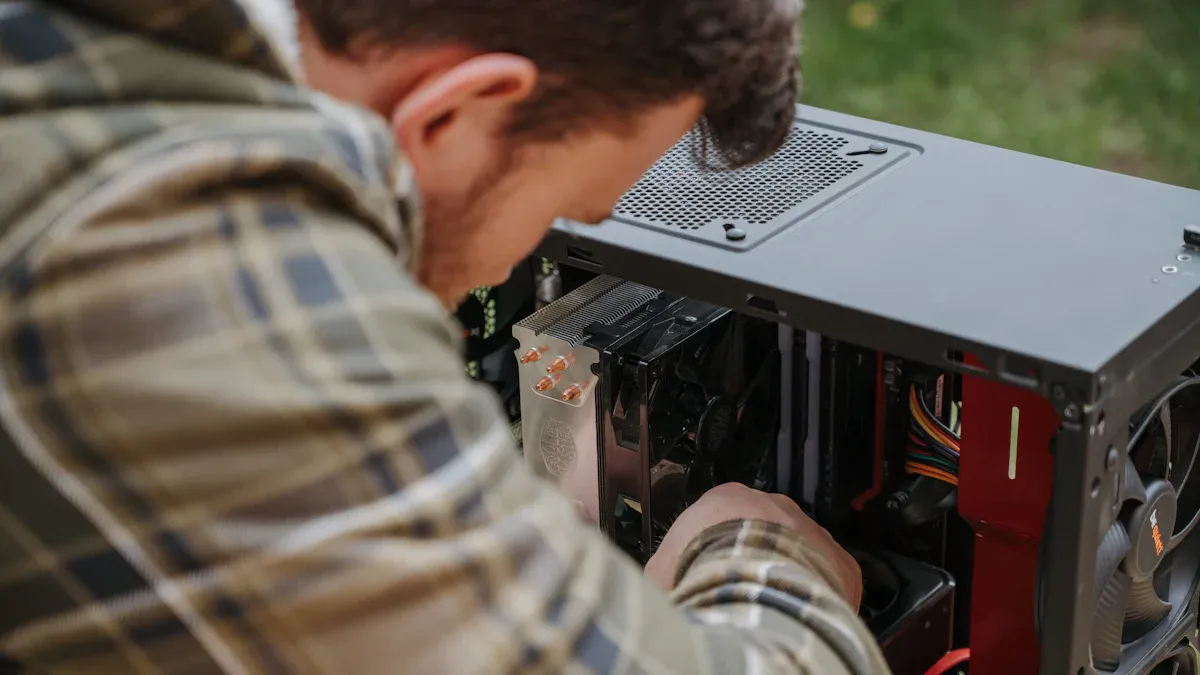Book Appointment Now
Why Is My Volvo Overheating? Causes & Fixes

If you own a Volvo, you might worry about Volvo overheating. It’s a common concern that can lead to serious engine damage if not addressed quickly. Understanding the signs of Volvo overheating, like coolant leaks or a faulty thermostat, is crucial. When you notice symptoms such as a rising temperature gauge or unusual warning lights, don’t ignore them. Taking immediate action can save you from costly repairs and keep your engine running smoothly.
Key Takeaways
Watch for signs of overheating, like a rising temperature gauge or warning lights. These indicators help you act quickly to prevent engine damage.
Regularly check your coolant levels. Low coolant can lead to overheating, so keep it topped off with the right mixture.
Inspect your vehicle for leaks. Look for puddles under your car and check hoses and the radiator for any signs of coolant loss.
If your engine overheats, pull over safely and turn off the engine. Allow it to cool down before checking coolant levels.
Follow a regular maintenance schedule. Routine checks and services can help prevent overheating and keep your Volvo running smoothly.
Signs of Volvo Overheating

Recognizing the early signs of overheating in your Volvo is crucial. Ignoring these symptoms can lead to severe engine damage. Here are some key indicators to watch for:
Temperature Gauge
Your Volvo’s temperature gauge plays a vital role in monitoring engine health. If you notice the gauge moving into the red zone, it’s a clear sign that your engine is overheating. Here’s a quick reference table to help you understand what different symbols mean:
Symbol | Meaning |
|---|---|
Thermometer inside a circle | Gearbox overheated/hot/cooled |
Radiator | Coolant level is low |
Thermometer above wavy lines | Temperature in the engine is too high |
Keep an eye on this gauge during your drives. If it starts to rise unexpectedly, take action immediately.
Warning Lights
Your dashboard warning lights are another critical indicator of overheating. The temperature gauge or warning light will illuminate if your engine is running too hot. Here are some common warning signs to look for:
A warning light on the dashboard
The temperature gauge indicating high levels
If you see any of these lights, don’t ignore them. They signal that your engine needs attention.
Steam or Smoke
Seeing steam or smoke coming from your engine compartment is a serious warning sign. This visible symptom indicates that your engine is overheating and requires immediate action. If you notice steam or smoke, pull over safely and turn off the engine. Here are some things to remember:
Steam or smoke is a clear indication of overheating.
It requires immediate attention to prevent severe damage.
Always be vigilant if you observe these signs while driving.
By staying alert to these signs of engine overheating, you can protect your Volvo from potential damage and costly repairs.
Causes of Volvo Overheating
Understanding the causes of Volvo overheating can help you take preventive measures and avoid costly repairs. Here are some common culprits that might lead to your engine overheating:
Low Coolant Levels
One of the primary reasons for engine overheating is low coolant levels. Coolant plays a crucial role in regulating your engine’s temperature. If your coolant is low, it can’t absorb heat effectively, leading to overheating. You should regularly check your coolant levels and top them off as needed.
Tip: Always use the recommended coolant type for your Volvo to ensure optimal performance.
Faulty Thermostat
A faulty thermostat can also cause your Volvo to overheat. The thermostat regulates the flow of coolant to the engine. If it gets stuck in the closed position, coolant can’t circulate properly. This blockage can lead to a rapid increase in engine temperature. If you suspect your thermostat is malfunctioning, consider replacing it to prevent further issues.
Clogged Radiator
A clogged radiator can severely impact your engine’s cooling efficiency. When debris or sediment builds up inside the radiator, it restricts coolant flow. This blockage can lead to overheating and engine damage. Here are some signs that your radiator might be clogged:
An unusual increase in engine temperature
The temperature gauge rising toward the red zone
If you notice these symptoms, it’s time to inspect your radiator. Regular maintenance can help prevent clogs and keep your engine running smoothly.
Coolant Leaks
Coolant leaks are another common cause of overheating in Volvos. Leaks can occur in various places, including:
Leaking radiator
Faulty hoses
Water pump issues
Blown head gasket
These leaks can lead to a significant loss of coolant, which is essential for keeping your engine cool. If you notice puddles of coolant under your vehicle or a sweet smell while driving, you may have a leak. Addressing these leaks promptly can save you from more severe problems down the road.
Air in the Cooling System
Air trapped in the cooling system can disrupt coolant flow, leading to engine overheating. The cooling system relies on a steady flow of coolant to regulate temperature. If air pockets form, they can block the coolant’s path, causing the engine to run hotter than normal. Signs of air in the system include:
Increased temperature shortly after starting the car
Fluctuating temperature gauge readings
To resolve this issue, you may need to bleed the cooling system to remove any trapped air. This simple maintenance step can help ensure your engine stays cool.
By understanding these causes of Volvo overheating, you can take proactive steps to keep your engine in good condition. Regular checks and maintenance can go a long way in preventing overheating issues.
Fixes for Engine Overheating

When your Volvo starts to overheat, it’s crucial to act quickly. Here are some immediate steps you can take to address engine overheating and prevent further damage:
Pull Over Safely
If you notice your engine overheating, the first thing you should do is pull over to a safe location. Here’s how to do it safely:
Find a Safe Spot: Look for a place away from traffic where you can stop your vehicle.
Turn Off the AC: This reduces the load on the engine. If it’s safe, turn on the heater to help draw heat away from the engine.
Turn Off the Engine: Once you’ve parked, turn off the engine to prevent further overheating.
Tip: Allow the engine to cool down for at least 10-15 minutes before opening the hood. This helps avoid burns or injuries.
Check Coolant Levels
After your engine has cooled, it’s time to check the coolant level. Here’s how to do it:
Open the Hood: Once it’s safe, open the hood to access the coolant reservoir.
Inspect the Coolant Level: Look at the coolant level in the overflow tank. If it’s low, you may need to add a mixture of 50% coolant and 50% distilled water.
Top Off if Necessary: If you find the coolant level is low, add the mixture to the appropriate level.
Regularly checking your coolant levels can help prevent overheating in the future.
Inspect for Leaks
Next, you should inspect your Volvo for any signs of coolant leaks. Here’s how to do it effectively:
Look Under the Vehicle: Check for puddles under your car. If you see greenish or yellowish fluid, it’s likely coolant.
Examine the Coolant Reservoir: Open the hood and inspect the coolant reservoir for low levels or consistent drops.
Check Hoses and Radiator: With the engine off and cool, visually inspect hoses, the radiator, and connections for cracks or dampness.
Use a Flashlight: Sometimes leaks hide in hard-to-see areas. A flashlight can help you spot them.
Perform a Pressure Test: If you suspect a leak but can’t find it, consider taking your Volvo to a professional for a pressure test.
By regularly inspecting for leaks, you can catch issues early and avoid overheating.
Allow Engine to Cool
After taking the above steps, it’s essential to let your engine cool down completely. This typically takes about 30 minutes. During this time, avoid opening the radiator cap while the engine is still hot, as this can cause hot coolant to spray out and lead to burns.
Note: If your Volvo continues to overheat after these steps, it’s best to consult a professional. They have the expertise to diagnose and repair complex overheating issues.
By following these steps to address engine overheating, you can help protect your Volvo from serious damage. Additionally, consider implementing long-term solutions to prevent future overheating:
Follow the manufacturer’s recommended service schedule.
Regularly inspect your vehicle for leaks and wear.
Flush the cooling system when necessary.
Always check and top off coolant levels.
Taking these proactive measures can keep your engine running smoothly and help you avoid the stress of an overheating car.
Preventing Volvo Engine Overheating
Keeping your Volvo in top shape is key to preventing overheating. Regular maintenance can save you from costly repairs down the road. Here are some essential practices to follow:
Regular Maintenance
You should regularly check fluid levels, including engine oil and coolant. Here’s a quick list of what to keep an eye on:
Change engine oil routinely to ensure effective lubrication.
Watch for any fluid leaks that could indicate underlying issues.
Monitor the temperature gauge while driving to prevent overheating.
Follow the recommended maintenance schedule for your vehicle.
By sticking to these practices, you can help your engine run smoothly and avoid overheating.
Monitor Coolant Mixture
Monitoring your coolant mixture is crucial. Many Volvo owners may not realize that small leaks can develop in the head gasket, especially in models like the S40. These leaks can lead to significant engine damage if left unchecked. Since there’s no low coolant sensor in many Volvos, you won’t get early warnings about coolant levels. This makes regular monitoring essential. Here’s how often you should check:
Inspect your coolant level a few times per year.
Adjust engine coolant as part of your regular maintenance routine.
Keeping an eye on your coolant mixture can help you prevent engine overheating.
Check for Leaks Periodically
Checking for leaks is another vital step in preventing overheating. You should inspect your coolant system regularly. Here’s what to do:
Look under your vehicle for any signs of coolant puddles.
Check the coolant reservoir for consistent drops in level.
Examine hoses and connections for cracks or dampness.
By checking for leaks periodically, you can catch issues early and keep your engine cool.
Taking these proactive steps can help you prevent engine overheating and keep your Volvo running smoothly for years to come.
In summary, addressing overheating issues in your Volvo promptly is crucial. Remember to keep an eye on coolant levels, check for leaks, and maintain your cooling system. If you notice persistent overheating, consider professional help to diagnose the problem effectively. Regular maintenance can save you from severe engine damage and keep your vehicle running smoothly. Stay proactive, and your Volvo will thank you!
FAQ
What should I do if my Volvo overheats while driving?
If your Volvo overheats, pull over safely, turn off the engine, and let it cool down. Check coolant levels and inspect for leaks. If the problem persists, consult a professional mechanic.
How often should I check my coolant levels?
You should check your coolant levels at least a few times a year. Regular checks help prevent overheating and ensure your engine runs smoothly.
Can I drive my Volvo if the temperature gauge is high?
No, driving with a high temperature gauge can cause severe engine damage. Pull over immediately and address the issue before continuing your journey.
What type of coolant should I use for my Volvo?
Always use the coolant type recommended in your owner’s manual. Using the correct coolant ensures optimal engine performance and prevents overheating.
How can I tell if my thermostat is faulty?
Signs of a faulty thermostat include fluctuating temperature readings and overheating. If you notice these symptoms, consider replacing the thermostat to avoid further issues.



